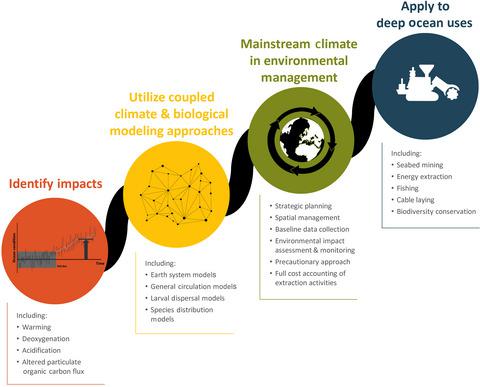当前位置:
X-MOL 学术
›
Glob. Change Biol.
›
论文详情
Our official English website, www.x-mol.net, welcomes your feedback! (Note: you will need to create a separate account there.)
Climate change considerations are fundamental to management of deep-sea resource extraction.
Global Change Biology ( IF 11.6 ) Pub Date : 2020-06-12 , DOI: 10.1111/gcb.15223 Lisa A Levin,Chih-Lin Wei,Daniel C Dunn,Diva J Amon,Oliver S Ashford,William W L Cheung,Ana Colaço,Carlos Dominguez-Carrió,Elva G Escobar,Harriet R Harden-Davies,Jeffrey C Drazen,Khaira Ismail,Daniel O B Jones,David E Johnson,Jennifer T Le,Franck Lejzerowicz,Satoshi Mitarai,Telmo Morato,Sandor Mulsow,Paul V R Snelgrove,Andrew K Sweetman,Moriaki Yasuhara
Global Change Biology ( IF 11.6 ) Pub Date : 2020-06-12 , DOI: 10.1111/gcb.15223 Lisa A Levin,Chih-Lin Wei,Daniel C Dunn,Diva J Amon,Oliver S Ashford,William W L Cheung,Ana Colaço,Carlos Dominguez-Carrió,Elva G Escobar,Harriet R Harden-Davies,Jeffrey C Drazen,Khaira Ismail,Daniel O B Jones,David E Johnson,Jennifer T Le,Franck Lejzerowicz,Satoshi Mitarai,Telmo Morato,Sandor Mulsow,Paul V R Snelgrove,Andrew K Sweetman,Moriaki Yasuhara

|
Climate change manifestation in the ocean, through warming, oxygen loss, increasing acidification, and changing particulate organic carbon flux (one metric of altered food supply), is projected to affect most deep‐ocean ecosystems concomitantly with increasing direct human disturbance. Climate drivers will alter deep‐sea biodiversity and associated ecosystem services, and may interact with disturbance from resource extraction activities or even climate geoengineering. We suggest that to ensure the effective management of increasing use of the deep ocean (e.g., for bottom fishing, oil and gas extraction, and deep‐seabed mining), environmental management and developing regulations must consider climate change. Strategic planning, impact assessment and monitoring, spatial management, application of the precautionary approach, and full‐cost accounting of extraction activities should embrace climate consciousness. Coupled climate and biological modeling approaches applied in the water and on the seafloor can help accomplish this goal. For example, Earth‐System Model projections of climate‐change parameters at the seafloor reveal heterogeneity in projected climate hazard and time of emergence (beyond natural variability) in regions targeted for deep‐seabed mining. Models that combine climate‐induced changes in ocean circulation with particle tracking predict altered transport of early life stages (larvae) under climate change. Habitat suitability models can help assess the consequences of altered larval dispersal, predict climate refugia, and identify vulnerable regions for multiple species under climate change. Engaging the deep observing community can support the necessary data provisioning to mainstream climate into the development of environmental management plans. To illustrate this approach, we focus on deep‐seabed mining and the International Seabed Authority, whose mandates include regulation of all mineral‐related activities in international waters and protecting the marine environment from the harmful effects of mining. However, achieving deep‐ocean sustainability under the UN Sustainable Development Goals will require integration of climate consideration across all policy sectors.
中文翻译:

气候变化因素是管理深海资源开采的基础。
通过变暖,氧气流失,酸化增加和有机碳通量变化(一种改变的粮食供应量),海洋中的气候变化表现预计会随着人类直接干扰的增加而影响大多数深海生态系统。气候驱动因素将改变深海生物多样性和相关的生态系统服务,并可能与资源开采活动甚至气候地球工程造成的干扰相互作用。我们建议,为了确保有效管理增加对深海的利用(例如,用于海底捕鱼,石油和天然气开采以及深海底采矿),环境管理和制定法规必须考虑气候变化。战略规划,影响评估和监控,空间管理,预防措施的应用,采掘活动的全额成本核算应包含气候意识。应用于水和海底的气候和生物建模方法相结合,可以帮助实现这一目标。例如,海底气候变化参数的地球系统模型预测揭示了深海底采矿目标区域的预计气候灾害和出苗时间(超出自然可变性)的异质性。将气候引起的海洋环流变化与颗粒追踪相结合的模型预测气候变化下早期生命阶段(幼虫)的运输发生了变化。生境适宜性模型可以帮助评估幼虫传播方式改变的后果,预测气候变化以及确定气候变化下多种物种的脆弱区域。与深入的观测社区合作可以支持必要的数据提供,以将气候问题纳入制定环境管理计划的主流。为了说明这种方法,我们重点关注深海底采矿和国际海底管理局,其职责包括管制国际水域中所有与矿物有关的活动,并保护海洋环境免受采矿的有害影响。但是,要在联合国可持续发展目标下实现深海可持续性,就需要在所有政策部门中整合气候考虑因素。其任务包括管理国际水域中所有与矿物有关的活动,并保护海洋环境免受采矿的有害影响。但是,要在联合国可持续发展目标下实现深海可持续性,就需要在所有政策部门中整合气候考虑因素。其任务包括管理国际水域中所有与矿物有关的活动,并保护海洋环境免受采矿的有害影响。但是,要在联合国可持续发展目标下实现深海可持续性,就需要在所有政策部门中整合气候考虑因素。
更新日期:2020-08-11
中文翻译:

气候变化因素是管理深海资源开采的基础。
通过变暖,氧气流失,酸化增加和有机碳通量变化(一种改变的粮食供应量),海洋中的气候变化表现预计会随着人类直接干扰的增加而影响大多数深海生态系统。气候驱动因素将改变深海生物多样性和相关的生态系统服务,并可能与资源开采活动甚至气候地球工程造成的干扰相互作用。我们建议,为了确保有效管理增加对深海的利用(例如,用于海底捕鱼,石油和天然气开采以及深海底采矿),环境管理和制定法规必须考虑气候变化。战略规划,影响评估和监控,空间管理,预防措施的应用,采掘活动的全额成本核算应包含气候意识。应用于水和海底的气候和生物建模方法相结合,可以帮助实现这一目标。例如,海底气候变化参数的地球系统模型预测揭示了深海底采矿目标区域的预计气候灾害和出苗时间(超出自然可变性)的异质性。将气候引起的海洋环流变化与颗粒追踪相结合的模型预测气候变化下早期生命阶段(幼虫)的运输发生了变化。生境适宜性模型可以帮助评估幼虫传播方式改变的后果,预测气候变化以及确定气候变化下多种物种的脆弱区域。与深入的观测社区合作可以支持必要的数据提供,以将气候问题纳入制定环境管理计划的主流。为了说明这种方法,我们重点关注深海底采矿和国际海底管理局,其职责包括管制国际水域中所有与矿物有关的活动,并保护海洋环境免受采矿的有害影响。但是,要在联合国可持续发展目标下实现深海可持续性,就需要在所有政策部门中整合气候考虑因素。其任务包括管理国际水域中所有与矿物有关的活动,并保护海洋环境免受采矿的有害影响。但是,要在联合国可持续发展目标下实现深海可持续性,就需要在所有政策部门中整合气候考虑因素。其任务包括管理国际水域中所有与矿物有关的活动,并保护海洋环境免受采矿的有害影响。但是,要在联合国可持续发展目标下实现深海可持续性,就需要在所有政策部门中整合气候考虑因素。


























 京公网安备 11010802027423号
京公网安备 11010802027423号